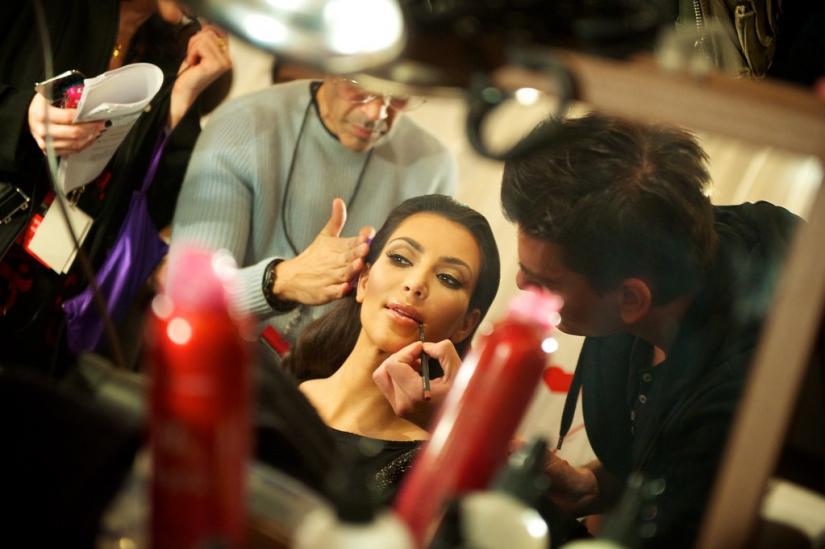
Image: Flickr / The Heart Truth
Capital is a term usually used for financial assets, such as money in the bank, however building media exposure can also act like a currency, says UTS Associate Professor of Marketing Francois Carrillat.
Just ask Kim Kardashian West, whose net worth is now estimated to exceed US $350 million, or her 21-year-old half-sister Kylie Jenner, reportedly the world’s youngest billionaire.
Celebrities build “celebrity capital” through repeated media exposure, primarily mass media – TV, radio, newspapers, magazines and movies – but also increasingly via social media channels and blogs.
Listen to Think: Business Futures with Associate Professor Francois Carrillat on 'The social capital of celebrities and influencers'.
They can then cash in on their fame, either literally – by endorsing products and appearing in advertising – or in other ways, such as exchanging it for political, symbolic or social capital – a concept first described by social scientist Pierre Bourdieu.
“Celebrity capital can be exchanged for political capital through influencing policy or endorsing candidates, (or even becoming a politician ) or for social capital by harnessing the benefits from networking with influential people,” says Associate Professor Carrillat.
Most often it is sports stars, actors and singers who achieve celebrity status, however experts in any domain can build celebrity capital – from chefs to finance gurus.
“One way to look at what makes someone a celebrity is to consider whether people outside their domain of expertise are interested in them,” says Associate Professor Carrillat.
“A golfer only becomes a celebrity if they are talked about outside the world of golf. As their fame grows, they are interviewed across a range of media, not just in the sports pages,” he says.
In a new study, 'The Celebrity Capital Life Cycle: A Framework for Future Research Directions on Celebrity Endorsement' published in the Journal of Advertising, Associate Professor Carrillat and co-author Associate Professor Jasmina Ilicic from Monash University examine how celebrity capital can fluctuate during someone’s career.
“The concept of celebrity capital, or more broadly celebrity recognisability, can be examined over time and through different stages, similar to a product lifecycle,” says Associate Professor Carrillat.
Many companies make huge investments in celebrity sponsorship. The value of Nike’s endorsement contracts totalled $9.4 billion in 2016, or roughly one-quarter of its revenue for the year. So knowing the right time to sponsor a celebrity can be an important business decision.
Puma’s first contract with Usain Bolt is considered one of the best endorsement deals because the brand signed the track-and-field athlete when he was only 16 years old, long before he won eight Olympic gold medals.
“This foresight saved Puma millions in comparison with waiting for Bolt’s early success on the international scene. Understanding the signs of a future superstar could be very useful to marketers,” says Associate Professor Carrillat.

Image: Flickr
Celebrity capital usually falls in value when a celebrity is involved in a scandal or controversy, often also reflected in a share price fall for companies linked to the celebrity involved. However, sometimes controversy can be beneficial or even bankable.
“While most brands prefer their celebrity endorsers to stay out of trouble, the world of luxury fashion seems to have different rules,” says Associate Professor Carrillat.
Justin Bieber became the new face of Calvin Klein when his reputation dropped to record lows and Kate Moss found favour with French luxury house Longchamp when her problems with cocaine and alcohol became headline news.
“When the type of endorser controversy matches with the strategy of the endorsed brand, celebrity scandals can yield positive outcomes,” explains Associate Professor Carrillat.
Research has backed this up, with another study 'Celebrity endorsement in the world of luxury fashion – when controversy can be beneficial' by Associate Professor Carrillat and co-author Dr Anne-Maree O’Rourke in The Journal of Marketing Management, which reveals that if a fashion brand is changing its positioning, having a controversial celebrity can help.
"Consumer attitudes towards a luxury fashion brand were generally more positive when a naturally controversial celebrity endorsed a brand with a reinforcement strategy, and when an incidentally controversial celebrity endorsed a brand with a revitalisation strategy," he says.
While it is not always the case that any exposure is good exposure, for those trying to build wealth through the power of celebrity, and for the fashion brands they endorse, it seems it may not hurt either.

